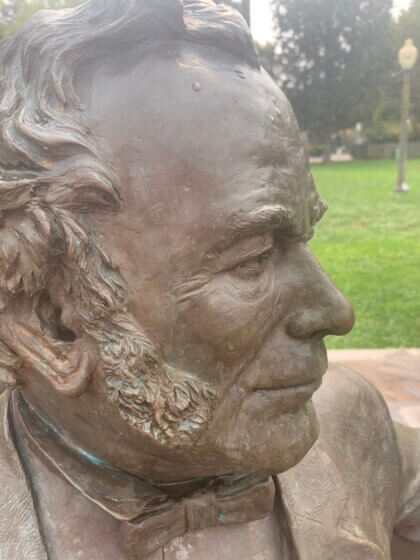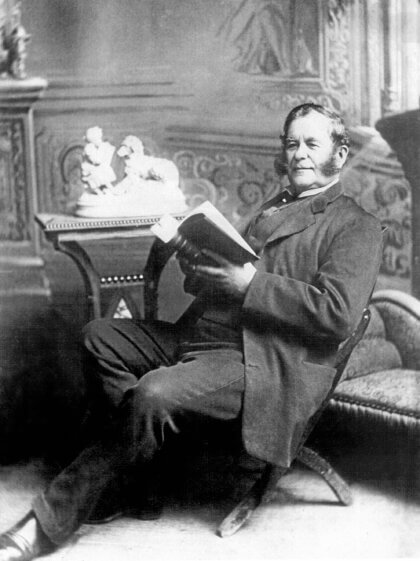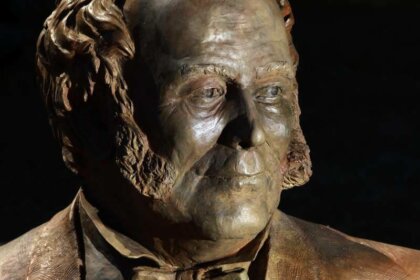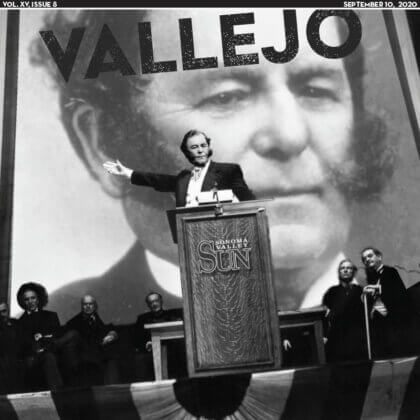The General Problem
How do we reconcile the grand history – and troubled legacy – of Mariano Vallejo?
By Leslie Nicholson | Sonoma Valley Sun
The rough and raw lands of northern California in which General Mariano Vallejo found himself in 1835, by orders of the Mexican Government, are still shifting and changing with time. Despite the over a century-and-a-half that has passed since he wielded his governmental powers to establish the town of Sonoma, there is a renewed spirit in the community to rewind history and revisit how Vallejo’s leadership looks in today’s 2020 America.
But how do you hit the reset button on local history? How do you come up with a workable solution to deep-rooted traditions and beliefs about Sonoma’s beginnings as a community that allows us to co-exist and move forward? Do we reinforce the long-held stories about his leadership, or come together to hammer out a refined history of Vallejo, one that is currently mired in debate among the historians and human rights leaders in Sonoma Valley?

The call for more transparency and inclusion is due to rising voices against racism and its place in American life, past and present. Vallejo’s statue in the Plaza and his role in Sonoma’s identity has come under renewed scrutiny. Nationally and locally, the move to reexamine historic individuals and events in our country’s past has gained momentum.
Locally, the debate and emotions over the positive and negative aspects of Vallejo’s legacy run deep. The division in the community is made up of people feeling that his contributions are being unfairly attacked and another faction of Sonomans voicing their feelings about a need to down-play his legacy and revisit his history for accuracy.
Local historians and human rights activists differ over how to approach a symbol of the community that has stood for generations as a representation of the “pioneer spirit” that we still commemorate today. But many people feel that many who worked and built our community, particularly Native Americans, have been forgotten and belittled in the pages of our history. And their cruel treatment by white settlers is a source of pain and anguish, even today.
Historian George McKale, hired in 2008 as the City’s first historian, also had a successful career as an archaeologist and is a board member of the Sonoma League for Historic Preservation. “We are at an interesting time in United States history. When it comes to issues with statues and monuments, we have to be clear about what we are or are not defending,” explains McKale. “We have to look at the good, bad, and ugly of history. We will always be correcting and educating about our history. We can’t stop doing that, it is the right thing to do.”
As for Vallejo’s legacy, McKale said there needs to be a clarification made between celebrating Vallejo or acknowledging what he contributed to Sonoma’s beginnings.
“The important issue is how do we commemorate a man who is a unique and important part of California history, but who was also a flawed leader who treated people with disregard and allowed for brutality,” he continues.
“What we need to take into account is that Vallejo’s achievements are a source of pride for Sonoma’s Latino community. I don’t see a need to villainize him until someone can come up with valid proof that he was involved in some of the crimes he is accused of when he was in control,” explains McKale. “We need to stick to the facts about his life. Presenting history is like sex, drugs, and rock-n-roll. It isn’t always pretty, but hiding it when instead we should be educating people about the history of our area and people who had the greatest impact on how we came to be. Books are always being published that give us a new perspective on history,” he adds. “I hope that the community moves from doing away with Vallejo’s history, as flawed as it may be in some ways, and instead keeps talking about how we can create a history that is more holistic and includes Native Americans, Spanish, African-Americans, Mexicans, and Americans in the story.”

As the former Chair of the Sonoma County Commission on Human Rights, D’mitra Smith has spent years immersing herself in the historic writings of the lives of indigenous and African-American people of Northern California and their struggles for freedom in the early days of California. The documentation that she bases her findings on portrays a culture where slavery was accepted and has since been put into the shadows of our local history, minimizing people of color in our community and focusing away from what wrongs have never been brought to light and justified.
“The glossing over of this information, the belittling of so many people whose labor was vital to the success of California, makes me wonder why we are not talking about it. We should not be celebrating slave owners. People like Vallejo have had their time. We now have the opportunity to replace the statues that have been celebrated because we have been forced to look through the lens of history as it is told by white supremacists,” Smith explains. “Put up statues of the indigenous people of this valley instead. I truly believe that we should not be criticized for speaking out. We should not be afraid to look at this history, and it is important to acknowledge what truly was happening as the state was being governed by white men who were oppressing Black, Indigenous people of color.”
She explains what she sees as the steps we need to take to make amends for past wrongs, “I believe that we need to have a formal apology and statement of condemnation made by Sonoma’s City Council as an honest gesture to the Miwok, Pomo, Wappo, Wintun, and Miyakmas, whose ancestors suffered under Vallejo or any leader of our community; this is a necessary first step to any meaningful healing.”
Well-known Sonoman, celebrated historian, and retired Sonoma State University Professor Patrick Garcia is a fifth-generation, second cousin to Vallejo. He takes a different approach to the history of Vallejo and encourages people to take a more in-depth look at history.
“Look at the details and have an open mind about history. There are a lot of contradictions about the Native Americans. My research into history shows that the Native Americans at the Petaluma Abode were given food, shelter, and their own areas to farm. I know there are arguments against that and I just hope people make the effort to understand the depth of history. I am open to listening to the many voices that need a chance to be heard,” he continues. “For example there has to be an awareness about such things as the conflicts that existed between tribes of Indians as well. Some wanted to control all of the tribes and there were Native Americans who were attacking other Native Americans,” he explains.
“I am a descendant of Mexicans and Native Americans. I have worked on many boards and for many causes, including fighting for the rights of the children of farm workers. I have also worked all over the world during my military service. I spent time in the Deep South working with black and white people during the 1960s,” adds Garcia. “I understand discrimination and how it continues to impact people today. Throughout my life and career, I have learned many things and I think that having a completely open mind, especially when looking at the details of history, is so incredibly important.”
Local artist and community advocate Michael Acker feels strongly that people should take the time to study local history.
“It boggles my mind that people haven’t talked about the Native Americans in Sonoma, while so much is always attributed to the Spanish, Mexicans, and Americans,” says Acker. “I would advise people to study history. That is what I am doing. We need to inform ourselves and know what happened.”
“Look around and what you will find is that what we know is undermined by actual history. Put yourself in the place of the Native Americans and other viewpoints. Don’t take what people say for granted. I am not advocating the removal of Vallejo’s statute, just do a better job of acknowledging Native Americans, their culture, and their culture before Europeans entered California,” says Acker.
In a recent webinar that was hosted by the Sonoma Land Trust, writer and local historical ecologist Arthur Dawson presented “Early Struggles for Civil Rights in California.”
Stating that he is still sorting out his own findings about Vallejo, he is an advocate for the Native Americans in early Sonoma. Dawson points out that Vallejo was industrious and welcomed the Americans. But he points out that Vallejo’s accomplishments are overshadowed by his preference for family and friends when it came to land distribution and how the treatment of Native Americans by Vallejo and his brother were discriminatory and brutal.
 “It is great to see the possibility of great community conversations about Vallejo’s legacy. I see that leaning toward more inclusivity, not putting him up on a high pedestal, and doing more to humanize him is a good thing,” explains Dawson. “It is tricky because he is a “poster child” for tourism and part of our local economic picture. The past gets romanticized and is a detriment to the truth. Things get overlooked, creating a bias and ultimately obscuring things we need to think about.”
“It is great to see the possibility of great community conversations about Vallejo’s legacy. I see that leaning toward more inclusivity, not putting him up on a high pedestal, and doing more to humanize him is a good thing,” explains Dawson. “It is tricky because he is a “poster child” for tourism and part of our local economic picture. The past gets romanticized and is a detriment to the truth. Things get overlooked, creating a bias and ultimately obscuring things we need to think about.”
Dawson continues, “It is interesting that the Sonoma Mission Indian Memorial that sits close to the sidewalk on First Street East, and honors more than 800 Native Americans (including over 200 children) who died while living and working at the Mission between 1824 and 1839, is a “silent memorial.” In contrast, Vallejo’s nearby statue gets all kinds of attention. Acknowledging the Native Americans who were here before Vallejo, and contributed so much to our beginnings, is something that is more than past due. It is very American to look up to someone who is wealthy and because of that we give them a great amount of respect and often put them on a pedestal.”
“It is time that we look at the history of Vallejo and think about the difference between honoring him and remembering him,” says Dawson. “There are a lot of things to reconsider when you look at how he set up a plantation system, and how he did nothing to vaccinate the Native Americans against smallpox during the pandemic of 1837, which resulted in 2,000 or so Native Americans dying of the disease. We don’t know if he was caught off guard, but he did vaccinate himself, his family, and people in his close circle.”
In an article written by John Sheehy in September 2019 for the Petaluma Argus-Courier newspaper, Sheehy writes about his research into the beginning of Vallejo’s downfall when he failed to immunize the Native Americans, which caused him to falter economically.
“Vallejo’s reasons for not providing natives with the vaccine were unknown. As one of the most powerful men in California, it’s doubtful he lacked the clout to obtain it (the Russians had reportedly supplied Mexicans the vaccine for the 1828 measles epidemic),” Sheehy writes. “But while revered as one of California’s most enlightened men, Vallejo was also at times egotistical, autocratic, and Machiavellian.”
Patricia Cullinan, president of the Sonoma Valley Historical Society, sums up a portion of the ongoing arguments surrounding historical facts and their portrayal.
“History is definitely complicated and messy, and fruitful discussion of events requires an understanding of the historical time and place before they can be interpreted. One of the difficulties in this, is that we tend to view the events of the past through our ‘contemporary’ eyes. This can create a barrier to dialog and understanding. We do need to move forward, to change and grow, but to do this we must first find a way to forgive, resolve, and heal from past wrongs,” says Cullinan.
“We are fortunate to live in a time of great awareness. We have new resources and knowledge that can shine light on the shaded and dark areas of the past,” reminds Cullinan.
“Since 1937, The Sonoma Valley Historical Society has worked diligently to both preserve our history and educate those who are curious about our past – through exhibits at the Depot Museum and various community events. Sonoma’s past is a part of our culture, and like in everything else, there are flaws. Future historians will judge how we come together now, as we discuss our differing viewpoints and continue to work toward a future that includes us all,” says Cullinan.
She adds, “Carl Becker, U.S. historian, (1873-1945), said this, ‘The value of history is, indeed, not scientific but moral: by liberalizing the mind, by deepening the sympathies, by fortifying the will, it enables us to control, not society, but ourselves – a much more important thing: it prepares us to live more humanely in the present and to meet rather than foretell the future.’ ”
6 thoughts on “The General Problem”
Comments are closed.





The first sentence in the article, without knowing it, takes the colonialist viewpoint:
“The rough and raw lands of northern California in which General Mariano Vallejo found himself in 1835…” The lands were “rough and raw” by definition of the European and American colonizers. They had to be deemed empty wilderness to justify their taking. In fact, as we know, the land was not only inhabited by people who had been there for thousands of years, it was managed by them, shaped by them, named by them, and loved by them.
“Local historians and human rights activists differ over how to approach a symbol of the community that has stood for generations as a representation of the “pioneer spirit” that we still commemorate today.” The “pioneer spirit” is a romanticized, valorized justification for the dispossession of the Native Americans.
“And their cruel treatment by white settlers is a source of pain and anguish, even today.” It is almost beside the point whether the colonizers were cruel or not. Their intention was not beneficent. They saw the land as theirs for the taking. Eradicate the people who were there or provide for them; either way the outcome would be dire.
I don’t know how we deal with our past. We, the descendants of the colonizers, are here and we are not going away, but I think we should be very conscious of the past, and tread very humbly. We are at this very minute paying the price; fire, for centuries old crimes.
Vallejo’s contribution is our beautiful Plaza! The Plaza is Sonoma. Imagine Sonoma without the Plaza. It would be like the thousands of communities which are just places with no civic center. Let’s study the past for what it was and learn from it but not impose contemporary values.
Contemporary values are exactly a problem of current projection.
There are few saviours in the world but many ‘best’ choices.
The part that galls me most is the treatment of the Bear Flaggers as “heroes.” Vallejo was treated unjustly and disrespected by these usurpers and thugs. As we dwell on the flaws and injustices of the General, don’t forget how Vallejo was imprisoned at Sutter’s Fort to ensure success of the American Takeover of Mexican Territory.
I totally agree.
The Plaza was not the Plaza we know. The Plaza we know is a Victorian creation, a park. It was a drill or parade ground for General Vallejo. Only a patch of bare dirt. The only thing I can say is that our country needs to change how we teach history to our children. We grow up with no idea of real history. We do not know the history of the original Americans nor do we know the suffering of slaves, Chinese laborers and others below the radar of “riches” who really built this country. And of course women are almost completely absent from text book history. It was not until I was in college that I began to understand and research the untold history of America. It started with a class in Native American art and history, taught by a Native American woman. It should have started in grade school.